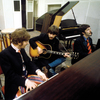
The Beatles, pictured here in 1969, just released what’s been billed as the band’s final song.
Bruce McBroom/© Apple Corps Ltd.
hide caption
toggle caption
Bruce McBroom/© Apple Corps Ltd.

The Beatles, pictured here in 1969, just released what’s been billed as the band’s final song.
Bruce McBroom/© Apple Corps Ltd.
Let’s get the most obvious critique out of the way first: “Now and Then,” the song billed as The Beatles‘ final single, can’t possibly live up to “Let It Be,” “Strawberry Fields Forever” or whatever happens to serve as your personal favorite Beatles song. The song began as a modest demo — just John Lennon, recording on a boombox at home in the late ’70s, with a TV on in the background — and it lives on as a modest demo that’s been blown out into a credible full-band production.
The story of that production is as interesting as the song itself, if not more so. The band began the process of gussying up “Now and Then” back in the mid-’90s, during the sessions that completed the previous “last Beatles songs” — namely 1995’s “Free As a Bird” and 1996’s “Real Love.” George Harrison even recorded a guitar part for “Now and Then,” which is crucial, given that he died in 2001. The problem: Given the original tape quality, a persistent hiss and the TV in the background, Lennon’s demo just wasn’t showroom-ready. They couldn’t isolate his vocal and piano enough to polish them up to where they needed to be, so the song was shelved.
That’s where artificial intelligence came into play. Using the same technology Peter Jackson used to restore the footage that formed his epic 2021 documentary The Beatles: Get Back, AI helped separate Lennon’s vocal, his piano and the extraneous background sounds and hisses that needed to be removed. For all the hand-wringing about The Beatles getting an assist from AI, this isn’t some zombie AI Lennon writing and performing a song from scratch.
Still, “Now and Then” never surpasses what it was destined to be: a heartfelt, lovingly rendered curiosity. It’s easy to see how Lennon’s words would take on greater meaning for surviving Beatles Paul McCartney and Ringo Starr, who surely look back on their departed friends with a mix of sadness and gratitude: “Now and then / I miss you / Oh, now and then / I want you to be there for me / Always to return to me.”
As that excerpt suggests, however, there’s not a whole lot to “Now and Then,” lyrically speaking, other than generalized appreciation, nostalgia and deep wistfulness. It’s a cocktail of emotions that’s appropriate to The Beatles, circa 2023, when half its members have died far too soon and the other half are looking back on Lennon’s words through the vantage point of their early 80s. But there’s not much insight here, and Lennon’s vocal — buffed up as it is — surely wasn’t up to how he’d have wanted the finished song to sound.
Which leaves us with four simple, improbably finished minutes of closure. “Now and Then” could never live up to the body of work that precedes it. But it could never diminish it, either. Best to let it be, then, and celebrate every Beatles moment we’ve got.


